Punjab State Board PSEB 5th Class EVS Book Solutions Chapter 14 Insectivorous Plants Textbook Exercise Questions and Answers.
PSEB Solutions for Class 5 EVS Chapter 14 Insectivorous Plants
EVS Guide for Class 5 PSEB Insectivorous Plants Textbook Questions and Answers
Textbook Page No. 88
Activity 1
The teacher can tell students the story of a farmer crossing the river with a goat, a bale of grass and a tiger.
Answer:
Do it yourself.
![]()
Question 1.
What is a food chain?
Answer:
The food chain in nature is formed by various animals; one animal eats another animal and in turn is eaten by another animal.
Activity 2
Observe carefully the organisms present around you and make a food chain on the basis of their relations of eating others and being eaten up.
Answer:
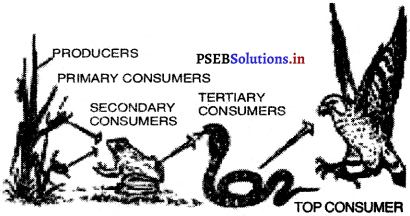
1. Cereals → Mouses → owl
2. grass → Rabbit → Wolf → lion
3 grass → insects → frog → snake → vulture Paste pictures of animals of the food chain.
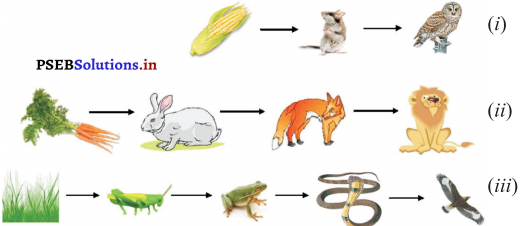
![]()
Textbook Page No. 89
Activity 3
What will happen to other organisms of food chain if one organism in a food chain disappears? Discuss in the class and write in the space given below :
Answer:
Consider a food chain consisting of grass, insects, frogs, snake and vultures. Suppose due to some reason all snakes got extinct. Then what will be the food of vultures. This way all the vultures will die soon due to non- availability of food. Now there will be no animal which will eat frog. Population of frogs will increase, they will eat all the insects and then nothing remains for the frogs, ultimately frogs will die.
Textbook Page No. 90
Activity 4
Write the names of different animals on cards and give them to the students. After this, ‘who eats whorn, should be linked with a thread. In this way, a food web is formed.
Answer:
Do it yourself.
Question 2.
What is food web?
Answer:
When many food chains are inter linked with each other they form a food web.
![]()
Textbook Page No. 91
Activity 5
Take a potted plant. Place a cardboard box with a hole on one side of the box. Note down the changes you observe in the plant after a few days.
Answer:
Plant bends towards light Therefore plant bends towards hole.
Activity 6
Pait a tree In the soil or pot in your house. Note down the requirements of the plant for its growth. Also note where does the plant meet its need from? Your teacher and your elders will help you.
Answer:
Do it yourself.
Textbook Page No. 92
Question 3.
Fill in the blanks:
(decayed, carbon dioxide, food-web, Green, Sun, Pitcher plant. Sundew plant, food chain.)
(i) In a ……………….. one organism can eat many other organisms.
(ii) In a ……………….. one organism eats only one organism.
(iii) ……………….. plants prepare their food in presence of ……………….. light.
(iv) Plants absorb ……………….. gas from the air.
(v) ……………….. and ……………….. are insectivorous plants.
(vi) Mushrooms get their food from ……………….. materials.
Answer:
(i) food-web,
(ii) food chain,
(iii) Green, sun,
(iv) carbondioxide,
(v) Sundew, Pitcher plant,
(vi) decayed.
![]()
Textbook Page No. 93
Question 4.
Tick (✓) the right and cross (✗) the wrong sentences a:
(i) Many food chains get interlinked to form a food web.
(ii) Leaves look green due to a pigment called chlorophyll.
(iii) Plants produce glucose in the form of food.
(iv) Plants pollute the environment.
(v) The leaves of Sundew Plant look like Sun.
Answer:
(i) ✓
(ii) ✓
(iii) ✓
(iv) ✗
(v) ✓
Question 5.
What is Photosynthesis?
Answer:
Green plants in the presence of sunlight absorb carbondioxide from air and absorb water and minerals from soil and synthesise their food. This process is known as photosynthesis.
Question 6.
How does the Pitcher Plant meet its requirements of Nitrogen and Phosphorus?
Answer:
Pitcher plant eats insects. Digestive juices of the plant extract nitrogen and phosphorus from the insects.
PSEB 5th Class EVS Guide Insectivorous Plants Important Questions and Answers
1. Tick the correct option :
(i) eats insects :
(a) Pitcher plant ( )
(b) Touch-me-not ( )
(c) Marigold ( )
(J) None. ( )
Answer:
(a) Pitcher plant
![]()
(ii) has a long tongue :
(а) Ant ( )
(б) Dog ( )
(c) Chameleon ( )
(d) None. ( )
Answer:
(c) Chameleon
(iii) Look at the food chain and tick the correct option:
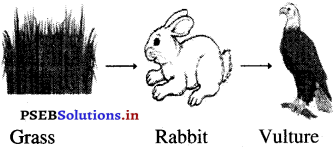
(a) eagle eats grass ( )
(b) rabbit eats vulture ( )
(c) rabbit eats grass ( )
(d) grass eats rabbit. ( )
Answer:
(c) rabbit eats grass
(iv) Food chains combine to form
(a) jungle ( )
(b) mixture ( )
(c) food web ( )
(d) group of animals. ( )
Answer:
(c) food web
![]()
2. Answer in one/two lines :
Question 1.
When one organism in a food chain also become component of other food chain what it is called?
Answer:
It is called food web.
Question 2.
How do plants prepare food?
Answer:
Plants prepare food in sunlight and by taking carbon dioxide from the air.
Question 3.
What is the process, of preparing food by plants called?
Answer:
It is called photosynthesis.
Question 4.
How does a plant absorb nutrients from soil?
Answer:
They absorb nutrients from soil with their roots.
Question 5.
Why a pitcher plant called so?
Answer:
Leaves of this plant look like pitcher, therefore it is called pitcher plant.
![]()
3. Fill in the blanks :
(i) Chameleon has a ……………………. tongue.
(ii) Plants prepare their food in the …………………… .
(iii) Plants take ……………………. gas.
(iv) Pitcher plant, gets nitrogen from …………………….
(v) ……………………. uses its hair-like structure to trap insects.
Answer:
(i) long,
(ii) sunlight,
(iii) carbon dioxide,
(iv) insects,
(v) Sundew.
4. True/False :
(i) Chameleon has a long tongue.
(ii) Frog has a long tongue.
(iii) Plants do not eat insects.
(iv) Money plant can eat insects.
Answer:
(i) T,
(ii) T,
(iii) F,
(iv) F.
5. Match the following column :
(A) – (B)
(i) insect eating plant – (a) frog
(ii) long tongue – (b) sundew
(iii) photosynthesis – (c) plants.
Answer:
(i) (b),
(ii) (a),
(iii) (c).
![]()
6. Mind Map :
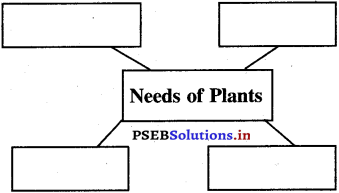
Answer:
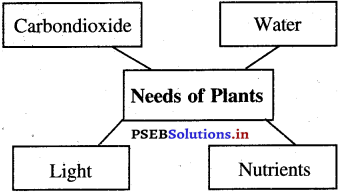
7. Answer in five/six lines :
Question 1.
How will you categorize animals on the basis of their food habits?
Answer:
We can categorize animals in three types.
- Herbivores. These are animals which only live on plants, fruits, leaves etc. e.g. goat, cow, deer etc.
- Carnivores. The animals eat other animals only e.g. lion, tiger etc.
- Omnivores. The animals which eat both plants and animals e.g. bear, monkey etc.
